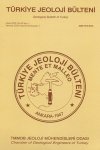
-
2025
-
2024
-
2023
-
2022
-
2021
-
2020
-
2019
-
2018
-
2017
-
2016
-
2015
-
2014
-
2013
-
2012
-
2011
-
2010
-
2009
-
2008
-
2007
-
2006
-
2005
-
2004
-
2003
-
2002
-
2001
-
2000
-
1999
-
1998
- 1997
-
1996
-
1995
-
1994
-
1993
-
1992
-
1991
-
1990
-
1989
-
1988
-
1987
-
1986
-
1985
-
1984
-
1983
-
1982
-
1981
-
1980
-
1979
-
1978
-
1977
-
1976
-
1975
-
1974
-
1973
-
1972
-
1971
-
1970
-
1969
-
1968
-
1966
-
1964
-
1963
-
1961
-
1959
-
1958
-
1955
-
1954
-
1953
-
1952
-
1951
-
1950
-
1949
-
1948
-
1947
Abstract: Regional metamorphic rocks of sedimentary origin in Afyon zone are known as Afyon metamorphites which are subdivided in two groups: Lower and upper metamorphites. The metamorphites are unconformably overlain by Anatolian carbonate platform belonging to Middle Devonian to Late Permian.The lower Metamorphite consist of Doğanlar schists, Çakmak quartzite and Sandıklı porphiroid (felsic volcanite). These metamorphism and by three plastic deformation phases (F, F2. F3) for the superposed folding probably during the Cambrian - Early Ordovician.The occurrences of the upper metamorphite consisting of D elikta§ meta - congolemerates. Ballıca phylUte and Iscehisar Marbleare reason for the second metamorphism. The later polyphase deformation (F4, F5, F6, F7) correspond the late stages of the Caledonian orogeny (Late Silurian).Afyon metamorphiles and Anatolian carbonate platform are named as Afyon metasedimentary group. The metamorphic evolution of Afyon metasedimentary group are before Mesozoic and were unconformably covered by Triassic sediments.
Abstract: In this paper, Ba and related elements Pb, Sr, Mn and Fe contents of investigated ores samples are geocliemically studied. Thestrongly variable barile values in ore reach up to 28%. MnO and FeO are dominant in comparision with BaO and PbO. Field andmicroscopic investigations indicate that barite is the only Ba - bearing phase. Ba values distribution is log - normal and correlateswith S, Pb and Sr positive. The Ba correlation with Ca and Mg is negative. FeO correlate with BaO + MnO positively and can beused for prospection on new mineralizations.Coexistence of barite with Mn and Fe oxides I hydroxides, coarse crystalline barile, itsoccurrence in sulfide ores too, high Pb and low S, Cu and Zn values, the positive correlation between Mn and As and the log - normal distribution of elements support exhalative sedimentary origin thesis for the deposits. Mn - Ba and FelMn-Ba variations showthe similarity of Keban argentiferous MN ore deposit to the exhalative sedimentary deposits En Kafala (Ethiopia) and Stromboli(Greece).
Abstract: Avcıpınarı sulfide mineralization occurs in the Eocene volcanics which include the basaltic andesites and luffs. The mineralization shows breccia -filling structure and the wall rock is altered tuffs. Mineral paragenesis of this mineralization is py rite (Pyrite I,II and III), marcasite, bravoite, chalcopyrite. sphalerite, galena, fahlore (termantite and goldfieldite), covellite - bornite, malachite -azurite, barite, gypsium and gel - silica. The predominant minerals are idiomorphic pyrite (Pyrite I) forming chemical zoning withbravoite and melnikovil - pyrite (Pyrite HI) wliich shows typical colloform and concentric textures.The wall - rocks, mineral paragensis. structure - texture features and chemcial analysis of the mineralization imply thai the mineralization occurred at the lowest temperature conditions of the hydrothermal process and Ni - Co content in bravoites is derivedfrom the ultramafic rocks.
Abstract: Mordenite type zeolitic alteration was identified in the Upper Cretaceous andesitic, dasitic rocks in Şile region, istanbul. Silisification (quartz and opal-CT) and low degree clay alteration (smectite and illite) were recognized in mordenite - rich samples, whilehigh degree clay alteration was determined in the samples which do not contain any mordenite mineralization. These alteration products have been developed in glassy components and also fill cavities and fissures of volcanic rocks. Besides, carbonate, chloriteand kaolinite type alterations were also identified in lioles and in pltenocryls. Mordenite crystals display thick tabular or prismaticmorplwlogy, 40x80 jum long. Hexagonal cross sections of the crystals have thicknesses changing in orders of 10 - 40 jU/n. The average chemical composition of the mordenite crystals can be expressed by the chemical formula of"Ca4j (Al!3Si36096). 11 H2O". DTAcurves of mordenites show endotherms at 110 XJ and 560 C According to the TGA curves of mordenitesthe total amount of weightloss below 950 V is about 11%.
Abstract: The rocks of Gümüşki area consist of units ranging in age from Jurassic to Tertiary. Jurassic aged Pontid Lower Basic Complex, which is composed ofspiliiic basalt, andesitic lavas and pyroclastics, is overlain by Malm - Lower Cretaceous aged Berdiga formation. Upper Cretaceous Ore - bearing dacites are the units with ore mineralization. In the region Dikkaya dacite and Kıranobaunit are also Upper Cretaceous in age and do not contain mineralization. Tertiary aged Zigana granitoid caused a contact metamorphism by cutting these units.In the area vein and massive sulphide type mineralizations are controlled by fracture system related to Valles - type caldera development. In the region the vein type ore deposits are important for Zn. Pb andAu mineralizations. Syngenetic par agenesis in theveins of epimesothermal character is given as sphalerite, galena, pyrite, chalcopyrite, fahlerz, freibergite, native gold and electrum.It is observed that gold, silver and cadmium increase with increasing antimony, leadandzinc, respectively.

 TMMOB
TMMOB